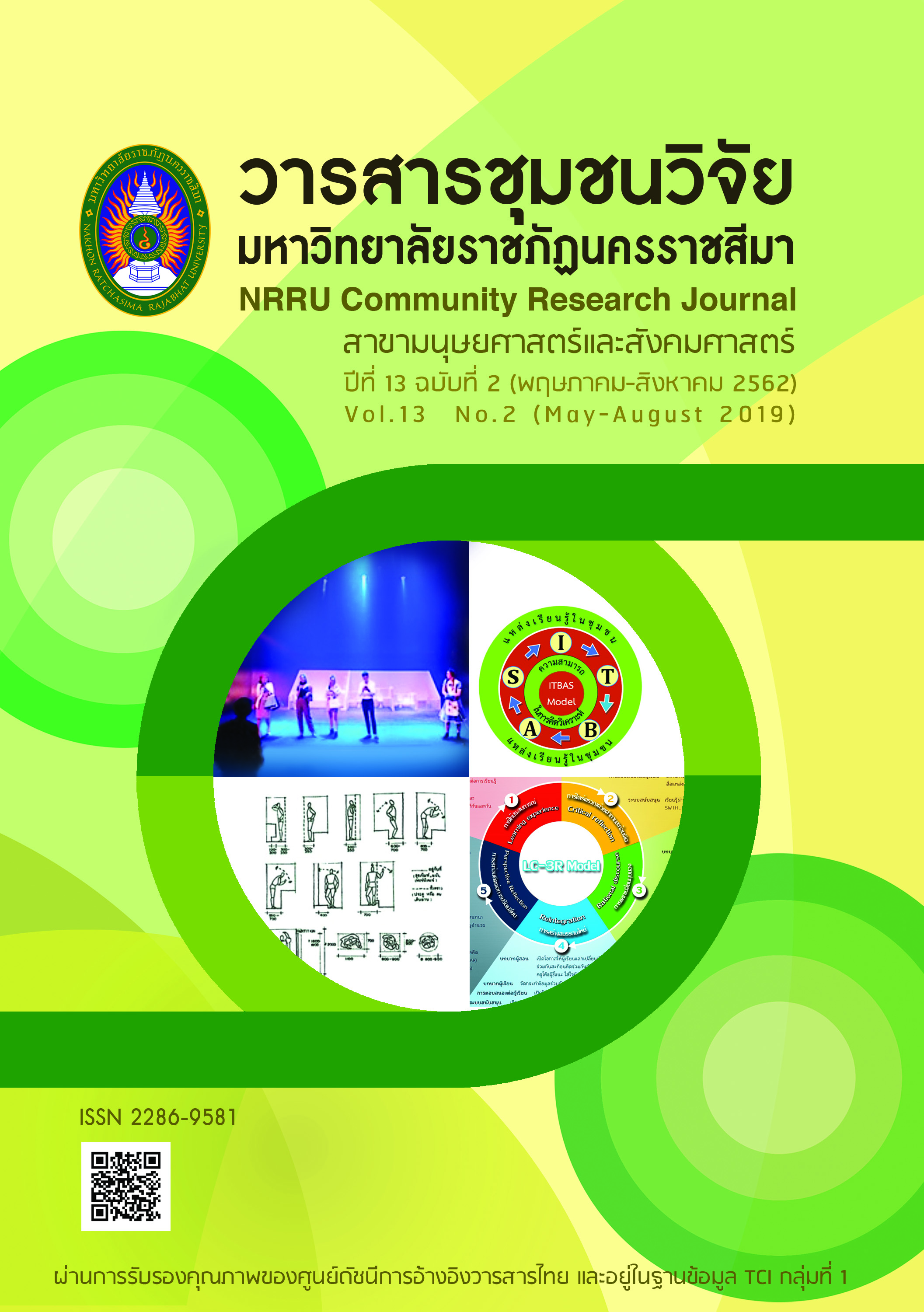SUASIVE MEASURES IN ENVIRONMENTAL MANAGEMENT FOR SUSTAINABLE LOW CARBON COMMUNITIES
DOI:
https://doi.org/10.14456/10.14456/nrru-rdi.2019.21Keywords:
ชุมชนคาร์บอนต่ำ สิ่งแวดล้อม การมีส่วนร่วมAbstract
The concept of low carbon community is for developing a sense of community and increasing societal awareness of environmental issues. However, there is less interest in understanding the nature of a low carbon community. Many studies view the concept of a low carbon community as something in the distant future. In this study, literature reviews are used to present the concept of low carbon communities under a sustainable community framework, using both International and Thai definitions. This means that a low carbon community promotes environmental conservation with tools, such as Environmental Management Measures (EMMs) that include synthesis from research and academic services. The objectives of this study are 1) to understand the nature of low carbon communities by changing behavior, 2) to offer approaches that promote low carbon communities by using suasive measures. It was found that building understanding of the community is important because of its driving force of change. Environmental management in terms of suasive measures should use to promote low-carbon communities before advancing economic and regulatory mechanisms. Suasive measures require no enforcement and there is inherent ‘grassroots’ support that can be developed into a national policy. As the main driver of environmental management measures, they will help low carbon communities develop into a truly sustainable society.
References
Amin, A.T.M., N. (2005). The Informal Sector’s Role in Urban Environmental Management. International Review for Environmental Strategies, 5(2), 511-530.
Burns, P., & Riechmann, C. (2004). Regulatory instruments and investment behavior. Utilities Policy. 12(2004), 211-219. Retrieved March 1, 2019, from https://ac.els-cdn.com/S0957 178704000712/1-s2.0-S0957178704000712-main.pdf?_tid=5e8644f1-6525-4aa1-8d70-684 ecc20cd05&acdnat= 1551406945_b11f7dced92fefc7c9b403f3726ab289.
Caulier-Grice, J. (2010). Social innovation exchange. Retrieved October 1, 2018, from https:// socialinnovator.info/blog/social-innovator/what-social-innovation.
Chanjirawuttikul, N. (2012). Leading the Way to Low Carbon Society: A Paradigm and Driving. TRF Policy Brief, 3(20). (In Thai)
Chavez, C. A., Vilena, M. G., & Stranlund, J. K. (2010). The choice of policy instruments to control pollution under costly enforcement and incomplete information. Journal of Applied Economics, 12(2), 207-227. Retrieved March 1, 2019, from https://www.sciencedirect .com/science/article/pii/S1514032609600131#!
Greyson, J. (2007). An economic instrument for zero waste, economic growth and sustainability. Journal of Cleaner Production, 15(13-14), 1382-1390. Retrieved March 1, 2019, from https://www.sciencedirect.com/science/article/pii/S0959652606002733
Harring, N., & Ronnerstrand, B. (2016). Government effectiveness, regulatory compliance and public preference for marine policy instruments. An experimental approach. Marine Policy, 71 (September 2016), 106-110. Retrieved March 1, 2019, from https://www. sciencedirect.com/ science/article/pii/S0308597X16303128#!
Janjirawuttikul, N. (2017). Low carbon society: a paradigm for development and driving. Retrieved October 1, 2018, from https://prp.trf.or.th/trf-policy-brief/สู่สังคมคาร์บอนต่ำ-กระ/ (In Thai)
Leknoi, U. (2017). Suburban community to green community driven guideline: Low Carbon Community. Journal of MCU Peace Studies, 5(2), 56-74. (In Thai)
_______. (2018). Guideline for building community engagement towards low carbon community in Bangkok Metropolitan. Journal of Environmental Management, 14(2), 78-95. Retrieved October 1, 2018, from https://www.tci-thaijo.org/index.php/JEM/article/view/106394/117119 (In Thai)
Matichon. (2016). The government and private sector join forces to bring Thailand into a "low carbon" society. Retrieved October 1, 2018, from https://www.matichon.co.th/news/6418 (In Thai)
Mingsheng, L., & Li, Y. (2012). Discussion on the Mode of China’s Low-carbon Society and Construction Routes. Chinese Journal of Population Resources and Environment, 10(1), 13-18.
Minh, N. T. B., & Amin, A.T.M., N. (2002). The role of foreign direct investment in urban environmental management: Some evidence from Hanoi, Vietnam. Environment, Development and Sustainability, 4(4), 279–297.
Nahman, A., & Godfrey, L. (2018). Economic instruments for solid waste management in South Africa: Opportunities and constraints. Resources, Conservation and Recycling, 54(8), 521-531. Retrieved March 1, 2019, from https://www.sciencedirect.com/science/article/pii/S092134490900233X#!
Niles, J. O., Brown, S., Pretty, J., Ball, A. S., & Fay, J. (2002). Potential carbon mitigation and income in developing countries from changes in use and management of agricultural and forest lands. Philosophical Transactions of the Royal Society of London A: Mathematical, Physical and Engineering Sciences, 360(1797), 1621-1639.
Permana, A. S., & Aziz, N.A. (2016). Land Use, Urban Mobility and Environment Nexus: Evidence from a Developing City. Universiti Teknologi Malaysia, ISBN: 978-983-52-1158-4.
Permana, A. S., Perera, R., Aziz, N. A., & Ho, C. S. (2015). Creating the Synergy of Land Use, Transport, Energy and Environment Elements towards Climate Change Co-benefits. International Journal of Built Environment and Sustainability, 2(1), 17-28. DOI: https://dx.doi.org/10.11113/ijbes.v2.n1.53
Potipituk, C. (2015). Low-Carbon Society Learning by Infographic Media : Case Study of Faculty of Architecture and Design, Rajamangala University of Technology Rattanakosin, Salaya. Retrieved October 28, 2018, from https://www.youtube.com/watch?v=gBl6yrWNE-E (In Thai)
Potipituk, C., & Permana, A. S. (2014). Barriers to the Implementation of Environmental Management Measures in the Operation of Shop House Enterprises in Bangkok Metropolitan Area. International Journal of Built Environment and Sustainability, 1(1),1-8. DOI:https://dx. doi.org/10.11113/ijbes.v1.n1.2 (In Thai)
Potipituk, C., Kaosal, S., Boonphoapichart, S, Thongmee, S.,Siriin, P. , Saisakorn, A. , Piyavajee, A, & Srisombat, C. (2018). Sustainable Communities: Basic Environmental Management for Residential Buildings. In 14th Asian Urbanization Conference “Sustainable Development Goals in Asia” (January 11-13, 2018). (In Thai)
Rathrung, C. (2012). Low-Carbon Society. Retrieved February 28, 2019, from https://low-carbon-society.blogspot.com/2012/02/blog-post.html (In Thai)
Saravia, M., Devenish, C., De Bièvre, B., & Peralvo, M. (2013). CONDESAN: Better knowledge, better decisions—supporting sustainable Andean mountains development. Mountain Research and Development, 33(3), 339-342.
Skea, J., & Nishioka, S. (2008). Policies and practices for a low-carbon society. Climate Policy 8. S5-S16.
Stern, J. (2014). The British utility regulation model: Its recent history and future prospects. Utilities Policy, 31 (December 2014), 162-172. Retrieved March 1, 2019, from https://www. sciencedirect.com/science/article/pii/S0957178714000666
Therdyothin, A. (2015). Holds 6 Energy Conservation Measures in Building Sector Following NAMAs Greenhouse Gas Emissions Reduction. Retrieved October 28, 2018, from https://www.manager.co.th/iBizchannel/viewNews.aspx?NewsID=9580000084651 (In Thai)
Yuttitham, M. (2009). Thailand Opportunity for CO2 Reduction through Carbon Credit in Sugarcane Production. Retrieved October 28, 2018, from www.myfirstbrain.com/student_view. aspx?id=75763.https://www.tei.or.th/news-environment/091228-1-01.pdf (In Thai)





